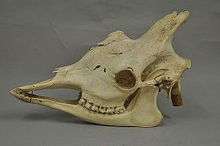Northern giraffe
The northern giraffe (Giraffa camelopardalis), also known as three-horned giraffe,[1] is the type species of giraffe native to North Africa.
- See Giraffe for details of how this proposed taxonomy fits with the currently accepted taxonomy of giraffes.
.jpg)
In the current IUCN taxonomic scheme, there is only one species of giraffe with the name G. camelopardalis and nine subspecies, but alternative taxonomic hypotheses have proposed two to eleven species.[2][3]
Once abundant throughout Africa since the 19th century, it ranged from Senegal, Mali and Nigeria from West Africa to up north in Egypt.[4] The West African giraffes once lived in Algeria and Morocco in ancient periods until their extinctions due to the Saharan dry climate.[5][6][4] It is isolated in South Sudan, Kenya, Chad and Niger.
All giraffes are considered Vulnerable to extinction by the IUCN.[3][7] In 2016, around 97,000 individuals from all subspecies were present in the wild.[7] There are currently 5,195 northern giraffes.
Taxonomy and evolution
In the current IUCN taxonomic scheme there is only one species of giraffe with the name G. camelopardalis and nine subspecies.[7][8]
Description

The northern giraffe has two horn-like protuberances known as ossicones on their foreheads. The northern giraffe's are longer and larger than that of the southern giraffes', though bull northern giraffes have a third cylindrical ossicone in the center of the head just above the eyes which are from 3 to 5 inches long.[1]
Distribution and habitat
The Northern giraffes live in the savannahs, shrublands and woodlands. After local extinctions in various places, the Northern giraffes are the least numerous species and the most endangered. In East Africa, they are mostly found in Kenya and southwestern Ethiopia, though rarely in northeastern Democratic Republic of the Congo and South Sudan. There are about 2,000 in the Central African Republic, Chad and Cameroon of Central Africa. Once widespread in West Africa, a few hundreds of Northern giraffes are confined at the Dosso Reserve of Kouré, Niger. They are common in both in and outside of protected areas.[3]
The earliest ranges of the Northern giraffes were in Chad during the late Pliocene. were once abundant in North Africa. They lived in Algeria since early Pleistocene during the Quaternary period. They lived in Morocco until their extinction around the year AD 600, as the dry climate of the Sahara made conditions impossible for the giraffes.[5] They are also extinct in Libya and Egypt.[6]
References
- Linnaeus, C. (1758). The Nubian or Three-horned giraffe (Giraffa camelopardalis). Existing Forms of Giraffe (February 16, 1897): 14.
- Petzold, Alice; Hassanin, Alexandre (2020-02-13). "A comparative approach for species delimitation based on multiple methods of multi-locus DNA sequence analysis: A case study of the genus Giraffa (Mammalia, Cetartiodactyla)". PLOS ONE. 15 (2): e0217956. doi:10.1371/journal.pone.0217956. ISSN 1932-6203. PMC 7018015. PMID 32053589.
- Muller, Z.; Bercovitch, F.; Brand, R.; Brown, D.; Brown, M.; Bolger, D.; Carter, K.; Deacon, F.; Doherty, J.B.; Fennessy, J.; Fennessy, S.; Hussein, A.A.; Lee, D.; Marais, A.; Strauss, M.; Tutchings, A. & Wube, T. (2016). "Giraffa camelopardalis". IUCN Red List of Threatened Species. 2016: e.T9194A109326950. doi:10.2305/IUCN.UK.2016-3.RLTS.T9194A51140239.en.{{cite iucn}}: error: |doi= / |page= mismatch (help)
- Alexandre Hassanin, Anne Ropiquet, Anne-Laure Gourmand, Bertrand Chardonnet, Jacques Rigoulet : Mitochondrial DNA variability in Giraffa camelopardalis: consequences for taxonomy, phylogeography and conservation of giraffes in West and central Africa. C. R. Biologies 330 (2007) 265–274. online abstract
- Anne Innis Dagg (23 January 2014). Giraffe: Biology, Behaviour and Conservation. Cambridge University Press. p. 5. ISBN 9781107729445. Retrieved 30 March 2017.
- Fred Wendorf; Romuald Schild (11 November 2013). Holocene Settlement of the Egyptian Sahara: Volume 1: The Archaeology of Nabta Playa. Springer Science & Business Media. p. 622. ISBN 9781461506539. Retrieved 30 March 2017.
- Muller, Z.; et al. (2016). "Giraffa camelopardalis (Giraffe)". IUCN Red List of Threatened Species. 2016. Retrieved 2017-05-02.
- Bercovitch, Fred B.; Berry, Philip S. M.; Dagg, Anne; Deacon, Francois; Doherty, John B.; Lee, Derek E.; Mineur, Frédéric; Muller, Zoe; Ogden, Rob (2017-02-20). "How many species of giraffe are there?". Current Biology. 27 (4): R136–R137. doi:10.1016/j.cub.2016.12.039. ISSN 0960-9822. PMID 28222287.